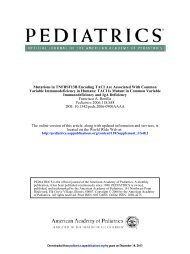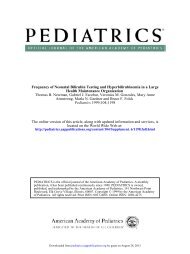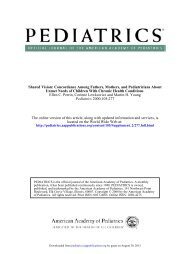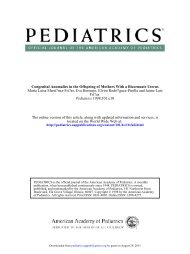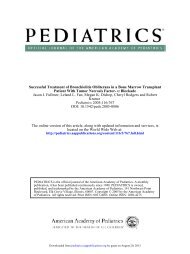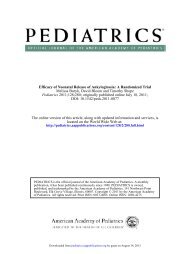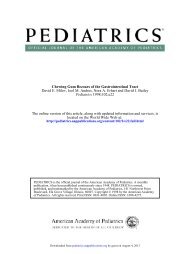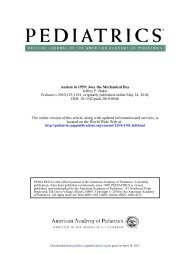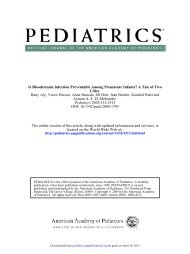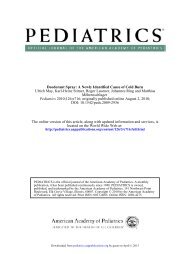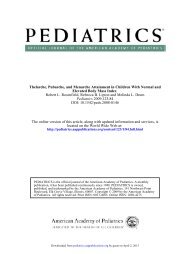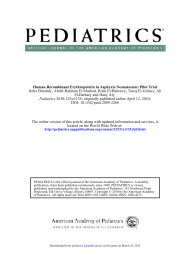Autoerotic Asphyxiation: Secret Pleasure—Lethal ... - Pediatrics
Autoerotic Asphyxiation: Secret Pleasure—Lethal ... - Pediatrics
Autoerotic Asphyxiation: Secret Pleasure—Lethal ... - Pediatrics
Create successful ePaper yourself
Turn your PDF publications into a flip-book with our unique Google optimized e-Paper software.
<strong>Autoerotic</strong> <strong>Asphyxiation</strong>: <strong>Secret</strong> Pleasure−−Lethal<br />
Outcome?<br />
Daniel D. Cowell<br />
<strong>Pediatrics</strong>;<br />
originally published online October 12, 2009;<br />
DOI: 10.1542/peds.2009-0730<br />
The online version of this article, along with updated information and services, is<br />
located on the World Wide Web at:<br />
http://pediatrics.aappublications.org/content/early/2009/10/12/peds.2009-0730.citation<br />
PEDIATRICS is the official journal of the American Academy of <strong>Pediatrics</strong>. A monthly<br />
publication, it has been published continuously since 1948. PEDIATRICS is owned,<br />
published, and trademarked by the American Academy of <strong>Pediatrics</strong>, 141 Northwest Point<br />
Boulevard, Elk Grove Village, Illinois, 60007. Copyright © 2009 by the American Academy<br />
of <strong>Pediatrics</strong>. All rights reserved. Print ISSN: 0031-4005. Online ISSN: 1098-4275.<br />
Downloaded from<br />
pediatrics.aappublications.org by guest on January 2, 2013
<strong>Autoerotic</strong> <strong>Asphyxiation</strong>: <strong>Secret</strong> <strong>Pleasure—Lethal</strong><br />
Outcome?<br />
WHAT’S KNOWN ON THIS SUBJECT: Centuries old, AEA first<br />
appeared in medical literature in 1856. Etiology is speculative,<br />
and the majority of reports deal with fatal cases. Distortions of<br />
normal development on the basis of psychoanalytic theories are the<br />
most prevalent understanding of the disorder.<br />
WHAT THIS STUDY ADDS: AEA is little known beyond forensic<br />
medicine and is generally regarded as a curiosity rather than a<br />
medical disorder whose onset is in childhood or adolescence.<br />
This study adds understanding of causation and provides guidance to<br />
pediatricians on recognition and management.<br />
abstract<br />
OBJECTIVE: Voluntary asphyxiation among children, preteens, and adolescents<br />
by hanging or other means of inducing hypoxia/anoxia to<br />
enhance sexual excitement is not uncommon and can lead to unintended<br />
death. This study addresses autoerotic asphyxiation (AEA) with<br />
the intent of increasing pediatricians’ knowledge of the syndrome and<br />
awareness of its typical onset among young patients. AEA is characteristically<br />
a clandestine and elusive practice. Provided with relevant information,<br />
pediatricians can identify the syndrome, demonstrate a<br />
willingness to discuss concerns about it, ameliorate distress, and possibly<br />
prevent a tragedy.<br />
METHODS: A retrospective study was undertaken of published cases<br />
both fatal and nonfatal and included personal communications, referenced<br />
citations, clinical experience, and theoretical formulations as to<br />
causation. Characteristic AEA manifestations, prevalence, age range,<br />
methods of inducing hypoxia/anoxia, and gender weighting are presented.<br />
All sources were used as a basis for additional considerations<br />
of etiology and possibilities for intervention.<br />
RESULTS: AEA can be conceptualized as a personalized, ritualized, and<br />
symbolic biopsychosocial drama. It seems to be a reenactment of intense<br />
emotional feeling-states involving an identification and sadomasochistic<br />
relationship with a female figure. Inept AEA practitioners can<br />
miscalculate the peril of the situation that they have contrived and for<br />
numerous reasons lose their gamble with death.<br />
CONCLUSIONS: Pediatricians should be alert to the earliest manifestations<br />
of AEA. Awareness of choking games among the young and, of<br />
those, a subset who eventually progress to potentially fatal AEA is<br />
strongly encouraged among all primary care professionals who may<br />
be able to interrupt the behavior. <strong>Pediatrics</strong> 2009;124:1318–1323<br />
1318 COWELL<br />
Downloaded from<br />
pediatrics.aappublications.org by guest on January 2, 2013<br />
AUTHOR: Daniel D. Cowell, MD, MLS, CPHQ<br />
Departments of Psychiatry and Behavioral Medicine and<br />
Graduate Medical Education, Marshall University, Joan C.<br />
Edwards School of Medicine, Huntington, West Virginia<br />
KEY WORDS<br />
asphyxiation, “choking games,” hypoxia/anoxia, lethal,<br />
masochism/sadism, sexual stimulation, suffocation, suicide<br />
ABBREVIATION<br />
AEA—autoerotic asphyxiation<br />
www.pediatrics.org/cgi/doi/10.1542/peds.2009-0730<br />
doi:10.1542/peds.2009-0730<br />
Accepted for publication Jun 4, 2009<br />
Address correspondence to Daniel D. Cowell, MD, MLS, CPHQ,<br />
Departments of Psychiatry and Behavioral Medicine, and<br />
Graduate Medical Education, Marshall University, Joan C.<br />
Edwards School of Medicine, 1600 Medical Center Dr, Suite 3414,<br />
Huntington, WV 25701. E-mail: cowell@marshall.edu<br />
PEDIATRICS (ISSN Numbers: Print, 0031-4005; Online, 1098-4275).<br />
Copyright © 2009 by the American Academy of <strong>Pediatrics</strong><br />
FINANCIAL DISCLOSURE: The author has indicated he has no<br />
financial relationship relevant to this article to disclose.
<strong>Autoerotic</strong> asphyxiation (AEA) is a clinical<br />
syndrome that is classified in the<br />
Diagnostic and Statistical Manual of<br />
Mental Disorders, Fourth Edition, Text<br />
Revision as a paraphilia, not otherwise<br />
classified. 1 It has been recognized for<br />
centuries in many cultures but did not<br />
appear in medical literature until<br />
18562 and 1866. 3 Little is known with<br />
certainty about its etiology or how<br />
widely dispersed individuals learn of<br />
the practice. It is estimated that there<br />
are 250 to 1200 deaths annually from<br />
AEA in the United States, although a<br />
7-year retrospective study by Sauvageau<br />
in one Canadian province suggested<br />
a lower incidence of autoerotic<br />
deaths and a higher percentage of female<br />
and “atypical” autoerotic fatalities<br />
than previously reported in US<br />
studies. 4 Estimates are almost certainly<br />
inaccurate, however, because<br />
the practice is characteristically enacted<br />
in secret, most cases do not end<br />
fatally (are therefore rarely reported),<br />
the activity is usually unknown to family<br />
and friends, and it is generally unrecognized<br />
by medical professionals.<br />
Troubled youth, of either gender, may<br />
engage in AEA for purposes of sexual<br />
experimentation. Authorities may be<br />
importuned by a decedent’s distraught<br />
family to declare the death a suicide<br />
especially if they have discovered the<br />
death scene; Burgess and Hazelwood5 detailed the impact on the family in<br />
such cases that calls for professional<br />
attention.<br />
The earliest manifestations of AEA may<br />
be so-called “choking games” among<br />
school-aged children, which seem to<br />
be increasing. These activities are<br />
known among teachers and educators<br />
from elementary grades through<br />
high school (T. LeGrow, PsyD, verbal<br />
communication, January 2009), and<br />
“highs” are also produced by vagal<br />
stimulation via a Heimlich-like maneuver<br />
(S. Lerfold, MD, verbal communication,<br />
February 2009). Anthropolo-<br />
TABLE 1 Impediments to Identification of AEA<br />
1. Patient embarrassment/shame<br />
2. Anticipation that disclosure will result in the physician’s discomfort, provoking judgment, repugnance,<br />
condemnation, or rejection (in part, this may represent a projection of his or her own<br />
self-condemnation upon the physician).<br />
3. Paraphilic thoughts/behaviors are experienced by the patient as odd but ego-syntonic and thus not a<br />
problem.<br />
4. The physician’s discomfort in taking a sexual history may stem from concerns involving his or her own<br />
sexuality or paraphilic thoughts or behaviors, resulting in distancing from similar behavior in the<br />
patient.<br />
5. The patient’s view that behavior that others regard as deviant (“abnormal”), whether experienced as<br />
acceptable or unacceptable to himself or herself, is a private matter that has no bearing in his or her<br />
consultations with physicians for what they regard as purely medical (or even psychiatric) reasons.<br />
6. The physician lacks knowledge of paraphilias and their manifestations, course, and preventive and<br />
therapeutic options.<br />
7. The sexual behavior of choking games or AEA may (mistakenly) be regarded as “harmless” or<br />
“victimless” by either the AEA practitioner or the physician.<br />
gists have recognized them in studies<br />
of primitive Celtic culture as well as<br />
among certain Native American and<br />
Eskimo children who engage in games<br />
of risk-taking involving suffocation<br />
called “Smoke Out” and “Red Out.” 6<br />
Andrew and Fallon7 noted an increase<br />
in lethality among young, risk-taking<br />
adolescents who engage in these asphyxial<br />
or choking games increasingly<br />
by using ligatures in solitary circumstances.<br />
These games are suggestively<br />
described: Black Hole, Black Out,<br />
Flatlining, Funky Chicken, Space Monkey,<br />
Suffocation Roulette, Gasp, Tingling,<br />
and Knock Out, among others. 8<br />
The authors’ series of 24 fatal cases,<br />
aged 9 to 16, suggests that when these<br />
youngsters see that the activity can be<br />
conducted without drugs, they falsely<br />
believe that they can create a “safe”<br />
high.<br />
The number of adult practitioners who<br />
engage in AEA is unknown, much less<br />
the number of children and adolescents<br />
involved in asphyxial games. AEA<br />
has achieved notoriety in television<br />
dramas and “talk shows.” There are, in<br />
fact, reports of AEA deaths related to<br />
such programming. 9 These portrayals<br />
are not helpful, because they sensationalize<br />
the practice and do not treat<br />
it as a little-known but dangerous medical<br />
disorder. For these reasons, it is<br />
important that primary care profes-<br />
ARTICLES<br />
sionals and especially pediatricians be<br />
informed about AEA, its manifestations<br />
and possible interventions.<br />
Impediments to revelation of sexual<br />
practices (unusual or otherwise) are<br />
described in Table 1, and findings that<br />
should raise suspicion are listed in Table<br />
2. It would be expedient for pediatricians<br />
to be familiar with paraphilias<br />
and especially the phenomenon of AEA<br />
in order to use a matter-of-fact, nonjudgmental<br />
approach when inquiring<br />
about it. Development of tolerance and<br />
respect for the great variety of sexual<br />
experiences, thoughts, and behaviors,<br />
often culturally conditioned, on the<br />
part of physicians as well as their patients<br />
is helpful. Even when no form of<br />
AEA is acknowledged, the patient will<br />
be comforted by the nature of the<br />
questions, which indicate that the pediatrician<br />
is informed about, open to<br />
discussing, and not repelled by an activity<br />
about which they themselves may<br />
be curious, troubled, or self-condemnatory;<br />
in time, they may be able to disclose<br />
their unique story. AEA is a good<br />
example of the principle that patients<br />
are more likely to reveal what is important<br />
to them when they believe that a<br />
physician is able to tolerate the information<br />
without risking dismissal, disapproval,<br />
or condemnation. This is<br />
true of many issues that trouble patients<br />
and none more so than those<br />
PEDIATRICS Volume 124, Number 5, November 2009 1319<br />
Downloaded from<br />
pediatrics.aappublications.org by guest on January 2, 2013
TABLE 2 Clues for Suspecting AEA<br />
1. Bruises of the neck or recurrent syncopal episodes in a child or an adolescent should prompt the<br />
pediatrician to inquire about “choking games” or the more elaborate AEA syndrome. (Physicians may<br />
be unaware that choking may engender feelings of pleasure, erection, and even orgasm.)<br />
2. Hesitant/tangential responses to a sexual history (in an adolescent) do not confirm AEA but may<br />
warrant additional inquiry (eg, “Do you ever play with death?” “Have you ever experienced giddiness or<br />
sexual stimulation if you are temporarily deprived of oxygen by choice or accident when roughhousing,<br />
inhaling a substance, or playing a choking game?” “Do you engage in risk-taking related to sexual<br />
stimulation or behavior?”).<br />
3. Is there evidence in the physical examination that an orifice has been repeatedly subjected to foreignbody<br />
insertion?<br />
4. Are there unusual, unexplained urogenital, vaginal, or anal injuries?<br />
5. Does the child or adolescent express concerns about sexual matters?<br />
6. Do abrasions found on limbs, wrists, ankles, or trunk suggest bondage or binding activities during<br />
masochistic practices? Is there ornamental piercing of intimate body parts?<br />
7. Are there erythematous or ligature marks on the penis or base of the scrotum?<br />
8. Do family members express concern about choking games that they have observed or heard about<br />
whether in their adolescent or their friends?<br />
that involve spirituality, sexuality, or<br />
death. The practice of AEA can involve<br />
all 3.<br />
METHODS<br />
By accessing PubMed-Medline, I found<br />
112 articles on AEA from 1950 to 2008,<br />
most in English, others in world literature.<br />
Published principally in forensic<br />
medicine/pathology, legal medicine,<br />
and toxicology journals, the great<br />
majority describe fatal cases (often<br />
initially but erroneously considered<br />
suicides.) Rare reports from AEA survivors;<br />
classics of world literature and<br />
drama; discussions with colleagues in<br />
general pediatrics, emergency and<br />
family medicine, psychiatry, and child<br />
psychology; referenced citations; and<br />
relevant psychoanalytic literature were<br />
all considered. The following representative<br />
sample of case reports is illustrative<br />
of age range, gender weighting, clinical<br />
manifestations, course, and geographic<br />
distribution.<br />
Sauvageau and Racette10 in Canada, by<br />
using Medline and all possible key<br />
words in their search of the literature<br />
from 1954 to 2004, found 408 published<br />
fatal cases ranging in age from 9 to 77<br />
years. Shields et al11 found 40 accidental<br />
fatalities in Hamburg, Germany, between<br />
1983 and 2003, all male, 13 to 79<br />
years of age. Jones et al12 in Edinburgh,<br />
1320 COWELL<br />
Scotland, reported 30 deaths from<br />
1984 to 1988, all from plastic bag asphyxiation,<br />
aged 13 to 81 years. Byard<br />
et al13 studied 8 rarely reported<br />
deaths in females and found distinctive<br />
differences vis-à-vis males.<br />
Among scant child and adolescent literature,<br />
Friedrich and Gerber14 took extensive<br />
histories from 5 adolescent male<br />
practitioners; each demonstrated childhood<br />
experiences with choking associated<br />
with egregious physical and sexual<br />
abuse. The terror felt by children and adolescents<br />
who, with fading consciousness,<br />
suddenly realize that escape mechanisms<br />
have failed and that death is<br />
imminent is unimaginable.<br />
Herman Melville described the eroticization<br />
of hanging in “Billy Budd” as did<br />
Heinz Ewers in “Alraune.” In Thomas<br />
Beckett’s “Waiting for Godot,” Vladimir<br />
and Estragon discussed stimulating<br />
ways of alleviating their boredom by<br />
hanging themselves while waiting for<br />
Godot. 15–17 Marquis de Sade described<br />
AEA in the same erotica in which sadism<br />
is eponymous. 18<br />
Curran et al19 claim that each individual<br />
develops his or her own AEA techniques,<br />
which become embellished<br />
and elaborated over time. Like other<br />
investigators, they found that to one degree<br />
or another, fatal cases presented<br />
a characteristic profile or syndrome<br />
(Table 3). They described stages ranging<br />
from early “sex play” (asphyxial<br />
games) to suspension activities in<br />
later adolescence and adulthood, including<br />
nudity, and, unlike females,<br />
with paraphernalia consisting of<br />
mirrors, pornography, bondage, and<br />
transvestite/fetishist articles such as<br />
female clothing. Atypical features were<br />
noted in 10% of cases that did not necessarily<br />
involve asphyxiation, including<br />
unintentional electrocution (cardiac<br />
arrest), whole-body wrapping<br />
(hyperthermia), foreign-body insertion<br />
(air embolism), and aquatic submersion<br />
(drowning). They did not consider<br />
asphyxial games as a forme<br />
fruste of AEA but rather a simpler, less<br />
elaborate, nonritualized activity without<br />
the need for escape mechanisms,<br />
pornography, and cross-dressing, which<br />
are typical of fully developed AEA, yet<br />
their description of stages suggests a<br />
possible link between early and later<br />
forms.<br />
DISCUSSION<br />
Downloaded from<br />
pediatrics.aappublications.org by guest on January 2, 2013<br />
Areas of Consensus<br />
Investigators agree that autoerotic behavior<br />
has a childhood or adolescent<br />
onset; that males outnumber females<br />
TABLE 3 Characteristics of Fatal AEA Cases<br />
Partial or complete asphyxiation while often but<br />
not always engaged in masturbatory activity<br />
Neck constriction by ligature or rope,<br />
asphyxiation by plastic bag and masks often<br />
with inhalants (nitrous oxide, trichloroethane,<br />
butane, chloroform, and others)<br />
Partial or complete nudity<br />
Binding of head, trunk, extremities, or genitals<br />
Insertion of dildos or other objects per rectum<br />
(or vagina)<br />
Pain, real or simulated, associated with<br />
occasional evidence of self-mutilation<br />
Pornography or bondage literature<br />
Mirrors positioned so that “victims” may see<br />
themselves in the predicament in which they<br />
have placed themselves (or were placed in<br />
their erotic fantasy)<br />
Transvestic elements, usually fetishist articles of<br />
feminine clothing (eg, undergarments,<br />
brassieres, dresses)<br />
Adapted from ref 19.
(as much as 50:1); and that it is a clandestine,<br />
often solitary, potentially lethal<br />
practice usually without suicidal<br />
intent among youthful practitioners.<br />
No biological or genetic markers have<br />
been identified. Postmortem findings<br />
are consistent with cerebral anoxia<br />
and physical findings related to its induction<br />
(eg, rope, ligature, suffocation).<br />
Money 20 suggested, however,<br />
that because certain medications have<br />
been modestly beneficial in treating<br />
paraphilias, there could be an anatomic<br />
and neurochemical basis for<br />
these behaviors.<br />
Etiologic Theories<br />
Traditional conceptualizations of AEA<br />
(and other paraphilias) rely on psychoanalytic<br />
concepts related to Freud’s<br />
theory of psychosexual development.<br />
Resnik, 6 for example, described AEA as<br />
“eroticized repetitive hanging,” noting<br />
no apparent wish to die and attempts<br />
to ensure that no visible mark would<br />
be detectable (suggesting concealment<br />
rather than suicidal intent). He<br />
reviewed other clinicians’ case reports<br />
and found common themes that<br />
he regarded as “upward displacement<br />
of castration anxiety” (ie, from the penis<br />
to the neck); others included oral<br />
sadism, 21 conflicts over oral incorporation<br />
by the mother and issues of separation/individuation,<br />
conflicts over<br />
bisexuality, 22 identification of the male<br />
enactor with the aggressor (mother or<br />
a female surrogate) according to Lowenstein,<br />
23 and conflicts or guilty anxiety<br />
over masturbation with or without<br />
incest fantasies.<br />
Resnik speculated that the neonate<br />
could feel smothered during unrelieved<br />
breastfeeding as well as during<br />
breath-holding while crying yet both<br />
associated with pleasurable sensations.<br />
He opined that these might be<br />
the earliest determinants of the<br />
search for similar sensations in later<br />
life (ie, heightened sensual experi-<br />
ences induced by hypoxia/anoxia/hypercapnia<br />
by means of neck compression,<br />
partial suffocation, or other<br />
methods). It is possible that pleasurable<br />
sensations in the infant/child<br />
from being playfully tossed in the air<br />
and caught by an adult (usually father)<br />
may also bear a relationship to later<br />
sexually stimulating experiences during<br />
suspension and hanging.<br />
Resnik theorized that there is a (virtual<br />
life and death) conflict for the infant<br />
between pleasurable sensations<br />
from unrelieved breastfeeding and the<br />
threat of suffocation, itself also associated<br />
with pleasurable sensations (one<br />
individual described recurrent, disturbing<br />
childhood dreams to me of being<br />
“smothered by white billows”).<br />
Resnik did not address nonbreastfed<br />
infants; I found no references to AEA<br />
among practitioners who had been<br />
bottle fed.<br />
Forensic Pathology<br />
Danto24 noted that up until 1980, there<br />
was only one report of a female and<br />
suggested that “the perversion reenacts<br />
(on an unconscious basis) the<br />
male victim’s feelings of emasculation<br />
by his mother (or via the mechanism of<br />
displacement by another dominantappearing<br />
female) who is seen as a<br />
powerful woman who controls her<br />
son’s masculinity: if he ”dies“ while he<br />
is wearing female attire, symbolically<br />
and on a fantasy level, his (unconscious)<br />
linkage is that it is his mother<br />
who “dies” (ie, is put to death.) In Danto’s<br />
view, the fantasy creator identifies<br />
with the victim. I concur with Danto,<br />
and an elaboration of this scenario is<br />
that when the sacrificial victim becomes<br />
the simultaneous murderer of<br />
his heartless seducer, the helplessness<br />
and powerlessness that he himself<br />
once felt is inflicted on her. Wesselius<br />
and Bally26 described just such a<br />
case in which hate/rage for both parents<br />
was combined with male–female,<br />
ARTICLES<br />
dominant–submissive, and sadomasochistic<br />
themes. It is no wonder that<br />
the complexity and persistence of this<br />
activity is mystifying to practitioners<br />
and its etiology obscure to researchers!<br />
Whether a mirror-image of these<br />
scenarios occurs with female practitioners<br />
is unknown; however, it is important<br />
to note that most estimates of<br />
autoerotic behavior among females<br />
are low (�4% in series of fatal cases),<br />
although they may be biased by cultural<br />
or societal taboos about acknowledging<br />
and reporting autoerotic<br />
behavior among women: a clinician<br />
would be well advised to include females,<br />
young or older, in contemplating<br />
the presence of autoerotic behavior.<br />
Core Dynamics<br />
In fully developed AEA, the male enactor<br />
assumes the role of a willing—or<br />
unwilling—sacrificial “victim” of a female<br />
who is perceived as being imperious<br />
and indifferent to the victim’s<br />
struggle to comply with her fantasied<br />
demands. AEA can thus be understood<br />
as a reenactment (or “acting out”) of<br />
powerful feeling-states originally related<br />
to a female (mother or surrogate).<br />
This “plot,” dimly understood if<br />
at all by the reenactor, may also represent<br />
a symbolic death for lustful<br />
thoughts and guilt-inducing masturbatory<br />
behavior (ie, punishment before<br />
pleasure!). In “surviving” the playacting<br />
death ritual, the individual<br />
emerges, time after time, sexually<br />
gratified and physically intact with a<br />
sense of relief, triumph, and contempt/resentment<br />
(ie, “You think I<br />
have died for you, but actually I killed<br />
you!”). AEA also involves a desire for<br />
control over the anxiety of life versus<br />
death: the closer the reenactor approximates<br />
yet cheats death, the<br />
greater the sexual excitement. It is indeed<br />
a curious state of affairs that the<br />
reenactor is the producer, director,<br />
choreographer, judge, actors, and witness<br />
in his or her unique, personalized<br />
PEDIATRICS Volume 124, Number 5, November 2009 1321<br />
Downloaded from<br />
pediatrics.aappublications.org by guest on January 2, 2013
drama. In essence, AEA reenacts a “life<br />
story” of unmanageable childhood<br />
trauma/conflicts. In Freud’s view, the<br />
repetition would be a compulsive but<br />
futile attempt to resolve those conflicts.<br />
26 “Learned helplessness” and demoralization<br />
could also be temporarily<br />
relieved by the exhilaration of AEA. 27<br />
Vicissitudes<br />
The normal developmental process of<br />
separation-individuation from parents<br />
can be difficult for a child with a<br />
controlling, demanding, or possessive<br />
mother and with a father or surrogate<br />
who is devalued, ineffective, passive,<br />
distant, or hostile. Under such circumstances,<br />
the male child’s unhappy, unstable<br />
(unconscious) identification is<br />
with both a powerful, demanding, and<br />
intimidating female and a distant,<br />
threatening, or devalued male; if the<br />
male child witnesses maternal abuse,<br />
then the identification with her will<br />
also be one of protectiveness. These<br />
identifications are repressed, and the<br />
child/adolescent is left with an unstable<br />
sense of who he or she “really is.”<br />
Humiliation and debasement also<br />
seem important in AEA exemplified by<br />
nudity expressing the reenactor’s low<br />
self-image (accentuated in adolescence<br />
but reflecting narcissism and<br />
exhibitionism as well) acted out before<br />
a female and a fantasied “witness”<br />
(father?). The erotic tension is heightened<br />
when the reenactor fantasizes<br />
that his or her own personal status<br />
is either superior or inferior to that<br />
of the female images (a dominance–<br />
submission scenario). From this perspective,<br />
pornography is not only an<br />
aid to arousal but also transforms ostensibly<br />
bizarre behavior into a veiled<br />
and poignant replication of highly conflicted<br />
relationships with key figures<br />
from that person’s past. Practiced<br />
long enough, fantasied relationships<br />
can erode, replace, or avoid entirely the<br />
need/desire for a mature relationship of<br />
mutuality with an actual partner.<br />
1322 COWELL<br />
Interventional Options<br />
Although it is unrealistic to expect general<br />
pediatricians to become experts<br />
in the management of complex biopsychosocial<br />
disorders such as AEA, familiarity<br />
with this paraphilia will be helpful<br />
in identifying and discouraging<br />
child/adolescent choking games that<br />
can progress to fully developed AEA.<br />
Uva, 28 for example, recommended preventive<br />
strategies such as including<br />
AEA in national or state electronic<br />
injury data systems, including such<br />
practices in school sex education programs<br />
for students and parents, and<br />
discouraging television producers<br />
from sensationalizing AEA. She would<br />
also teach mothers of newborns how<br />
to breastfeed infants properly to avoid<br />
partial asphyxiation and the hypothesized<br />
suffocation cycle (a technique<br />
generally taught to mothers who are<br />
breastfeeding).<br />
In some adult male paraphilics, reduction<br />
of the sex drive with an antiandrogen,<br />
such as medroxyprogesterone acetate<br />
(to lower testosterone levels),<br />
has been used successfully. 20 selective<br />
serotonin reuptake inhibitors, amyl nitrite,<br />
and lithium carbonate have been<br />
used with modest benefit in some<br />
adult paraphilics, perhaps most effectively<br />
when attention-deficit disorder,<br />
a comorbid mood disorder, or obsessive/<br />
compulsive disorder is present. 27,29 It is<br />
not recommended that any of these<br />
treatments for AEA be used in children<br />
or adolescents, because no large-scale<br />
double-blind studies have been conducted<br />
on medication use for that<br />
purpose.<br />
Educational content about AEA should<br />
be included in medical, nursing, and<br />
psychology curricula and for residents<br />
in primary care fields, psychiatry, and<br />
emergency medicine. It should be emphasized<br />
that choking practices are<br />
capable of causing unconsciousness<br />
in 7 seconds with as little as 7 pounds<br />
of pressure on the carotid sinus or ca-<br />
Downloaded from<br />
pediatrics.aappublications.org by guest on January 2, 2013<br />
rotid arteries. 30 Literary works such as<br />
“Waiting for Godot” and “Billy Budd”<br />
could be used in schools as incidental<br />
vehicles to discuss the peril associated<br />
with asphyxial games (in a manner<br />
that does not encourage experimentation<br />
but that would be no more<br />
“suggestive” than instruction on “safe<br />
sex” and condom use in primary<br />
grades). When opportunities present,<br />
pediatricians should be encouraged to<br />
speak to youngsters, parents, and<br />
teachers about choking games in the<br />
course of advocating other healthy lifestyle<br />
choices such as those on nutrition,<br />
immunizations, exercise, avoidance<br />
of addicting substances, and<br />
routine helmet and seatbelt use.<br />
Comorbidities of mood, anxiety, or substance<br />
abuse disorders can “unmask”<br />
paraphilias (AEA) and should be<br />
treated. Although anlage of AEA are<br />
most likely found among unmanageable<br />
early childhood conflicts that deflect<br />
and disturb the usual developmental<br />
course, they may be repressed<br />
by unconscious defense mechanisms.<br />
Intercurrent scholastic, peer, or family<br />
stressors (including violence and<br />
abuse) and pubertal hormonal changes<br />
together with idiosyncratic factors in<br />
the child/adolescent can overwhelm<br />
defenses, and AEA would then be manifested.<br />
Perhaps these are among the<br />
reasons that some asphyxial gamers<br />
develop the full AEA syndrome and others<br />
do not.<br />
Beyond consciousness-raising and educational<br />
opportunities, pediatricians<br />
would be well advised to consult with<br />
child psychiatrists or child psychologists<br />
who have experience in treating<br />
sexual disorders if additional therapeutic<br />
interventions are thought necessary.<br />
Interruption of a progression<br />
from choking games to fully developed<br />
AEA may require not only medication<br />
for comorbidities but also attention to<br />
Burgess’s aforementioned psychoso-
cial dimensions of issues for survivors<br />
and those who have observed autoerotic<br />
behavior but do not know what<br />
to do about it. Longer term treatment<br />
may consist of individual psychotherapy<br />
for the child/adolescent as well as<br />
psychoeducation and family psychotherapy.<br />
This is indicated when one or<br />
both parents deny the behavior, feeling<br />
embarrassed and defensive when<br />
confronted by this disturbing problem in<br />
their offspring. Therapeutic interventions<br />
must be employed skillfully lest parental<br />
anger and rejection aggravate the<br />
problem, driving the practitioner deeper<br />
into his or her solitary reenactments—or<br />
worse.<br />
CONCLUSIONS<br />
I believe that AEA represents a compulsion<br />
to reenact and thereby discharge<br />
REFERENCES<br />
1. American Psychiatric Association. Diagnostic<br />
and Statistical Manual of Mental Disorders-<br />
TR. 4th ed. Washington, DC: American Psychiatric<br />
Association; 1994<br />
2. DeBoismont A. Du Suicide et de las Folie Suicide.<br />
Paris, France: Germer Bailliere; 1856<br />
3. Von Krafft-Ebing R. Psychopathia Sexualis. Klaf<br />
F., trans. New York, NY: Stein and Day; 1965<br />
4. Sauvageau A. <strong>Autoerotic</strong> deaths: a seven-year<br />
retrospective epidemiological study. The Open<br />
Forensic Sciences Journal. 2008;1:1–3<br />
5. Burgess AW, Hazelwood RR. <strong>Autoerotic</strong> asphyxial<br />
deaths and social network response.<br />
Am J Orthopsychiatry. 1983;53(1):166–170<br />
6. Resnik H. Eroticized repetitive hanging: a form<br />
of self-destructive behavior. Am J Psychother.<br />
1972;26(1):4–21<br />
7. Andrew A, Fallon K. Asphyxial games in children<br />
and adolescents. Am J Forensic Med<br />
Pathol. 2007;28(4):303–307<br />
8. O’Halloran R, Lovell F. <strong>Autoerotic</strong> asphyxial<br />
death following television broadcast. J Forensic<br />
Sci. 1988;33(6):1491–1492<br />
9. Dietz P. Television-inspired autoerotic asphyxiation.<br />
J Forensic Sci. 1989;34(3):528–529<br />
10. Sauvageau A, Racette S. <strong>Autoerotic</strong> deaths in<br />
the literature from 1954 to 2004: a review.<br />
J Forensic Sci. 2006;51(1):140–146<br />
11. Shields L, Hunsaker D, Hunsaker J 3rd. Auto-<br />
(act out) intense feeling-states derived<br />
from distortions of very early development.<br />
Whenever and however it begins,<br />
sexual exhilaration produced by<br />
hypoxia/anoxia/hypercapnia, identification<br />
with females by cross-dressing, sadomasochistic<br />
scenarios, humiliation,<br />
and debasement, as well as “plot”<br />
embellishments and paraphernalia,<br />
seem to be characteristic of AEA, especially<br />
in males, more so with advancing<br />
age.<br />
The momentary exhilaration that AEA<br />
provides often leads to a lifetime of<br />
shame, mystification, self-condemnation,<br />
self-isolation, and hopelessness that<br />
can end in suicide. In recognizing AEA<br />
and when possible interrupting its<br />
course, a pediatrician may save a<br />
young life or at least alleviate a secret<br />
burden. It has been suggested that ed-<br />
erotic asphyxias: part I. Am J Forensic Med<br />
Pathol. 2005;26(1):45–52<br />
12. Jones L, Wyatt J, Busuttil A. Plastic bag asphyxia<br />
in southeast Scotland. Am J Forensic<br />
Med Pathol. 2000;21(4):401–405<br />
13. Byard RW, Eitzen DA, James R. Unusual fatal<br />
mechanisms in nonasphyxial autoerotic<br />
death. Am J Forensic Med Pathol. 2000;21(1):<br />
65–68<br />
14. Friedrich W, Gerber P. <strong>Autoerotic</strong> asphyxia: the<br />
development of a paraphilia. J Am Acad Child<br />
Adolesc Psychiatry. 1994;33(7):970–974<br />
15. Melville H. Billy Budd, Foretopman. In: Evans B,<br />
ed. The Shorter Novels of Herman Melville.<br />
New York, NY: John Day Co, 1929<br />
16. Ewers H. Alraune. New York, NY: John Day;<br />
1929<br />
17. Beckett T. Waiting for Godot. New York, NY:<br />
Grove Press; 1954<br />
18. Sade, Marquis de. Justine. In: Lely G, ed. The<br />
Marquis de Sade: A Biography. New York,<br />
NY: Grove Press; 1962<br />
19. Curran W, McGarry A, Petty C. <strong>Autoerotic</strong> <strong>Asphyxiation</strong>inModernLegalMedicine.Philadelphia,<br />
PA: FA Davies Co; 1980<br />
20. Money J. Paraphilias: phenomenology and<br />
classification. Am J Psychother. 1984;38(2):<br />
164–179<br />
ARTICLES<br />
ucational efforts to lift the veil of silence<br />
on these practices would not be<br />
preventive but rather would lead to<br />
imitative experimentation by thrillseeking,<br />
troubled children or teens.<br />
That premise seems unrealistic, because<br />
AEA seems to be more common<br />
than previously thought and, like other<br />
high-risk activities among this age<br />
group, should be discouraged by medical<br />
professionals.<br />
ACKNOWLEDGMENTS<br />
I thank Robert W. Williams, MLS, MA<br />
(Associate Professor of Libraries and<br />
reference librarian, Joan C. Edwards<br />
School of Medicine, Marshall University),<br />
and Trudi F. Jamison (secretary,<br />
Office of Graduate Medical Education,<br />
Joan C. Edwards School of Medicine)<br />
for invaluable help.<br />
21. Sterba R. On Spiders, Hanging and Oral Sadism.<br />
American Imago; 1950<br />
22. Newman LE, Stoller RJ. Spider symbolism and<br />
bisexuality. J Am Psychoanal Assoc. 1969;<br />
17(3):862–872<br />
23. Lowenstein R. A contribution to the psychoanalytic<br />
theory of masochism. J Am Psychoanal<br />
Assoc. 1957;5(2):197<br />
24. Danto B. A case of female autoerotic death.<br />
Am J Forensic Med Pathol. 1980;1(2):117–121<br />
25. Wesselius C, Bally R. A male with autoerotic<br />
asphyxia syndrome. Am J Forensic Med<br />
Pathol. 1983;4(4):341–345<br />
26. Freud S. Collected Papers. Vol V; London,<br />
England: Hargarth Press and Institute of<br />
Psychoanalysis; 1950<br />
27. Cesnik J, Coleman E. Use of lithium carbonate<br />
in the treatment of autoerotic asphyxia. Am J<br />
Psychother. 1989;43(2):277–286<br />
28. Uva J. Review: autoerotic asphyxiation in the<br />
United States. J Forensic Sci. 1995;40(4):<br />
574–581<br />
29. Kafka M. Sertraline pharmacotherapy for<br />
paraphilia-related disorders: an open trial.<br />
Ann Clin Psychiatry. 1994;6(3):189–195<br />
30. Berlyne N, Strachan M. Neuropsychiatric sequelae<br />
of attempted hanging. Br J Psychiatry.<br />
1968;114(509):411–422<br />
PEDIATRICS Volume 124, Number 5, November 2009 1323<br />
Downloaded from<br />
pediatrics.aappublications.org by guest on January 2, 2013
<strong>Autoerotic</strong> <strong>Asphyxiation</strong>: <strong>Secret</strong> Pleasure−−Lethal<br />
Outcome?<br />
Daniel D. Cowell<br />
<strong>Pediatrics</strong>;<br />
originally published online October 12, 2009;<br />
DOI: 10.1542/peds.2009-0730<br />
Updated Information &<br />
Services<br />
Citations<br />
Permissions & Licensing<br />
Reprints<br />
including high resolution figures, can be found at:<br />
http://pediatrics.aappublications.org/content/early/2009/10/12<br />
/peds.2009-0730.citation<br />
This article has been cited by 1 HighWire-hosted articles:<br />
http://pediatrics.aappublications.org/content/early/2009/10/12<br />
/peds.2009-0730.citation#related-urls<br />
Information about reproducing this article in parts (figures,<br />
tables) or in its entirety can be found online at:<br />
http://pediatrics.aappublications.org/site/misc/Permissions.xht<br />
ml<br />
Information about ordering reprints can be found online:<br />
http://pediatrics.aappublications.org/site/misc/reprints.xhtml<br />
PEDIATRICS is the official journal of the American Academy of <strong>Pediatrics</strong>. A monthly<br />
publication, it has been published continuously since 1948. PEDIATRICS is owned, published,<br />
and trademarked by the American Academy of <strong>Pediatrics</strong>, 141 Northwest Point Boulevard, Elk<br />
Grove Village, Illinois, 60007. Copyright © 2009 by the American Academy of <strong>Pediatrics</strong>. All<br />
rights reserved. Print ISSN: 0031-4005. Online ISSN: 1098-4275.<br />
Downloaded from<br />
pediatrics.aappublications.org by guest on January 2, 2013



